Page 1 of 1
Are these the same
Posted: Fri Jun 17, 2022 1:03 pm
by Been Here Before
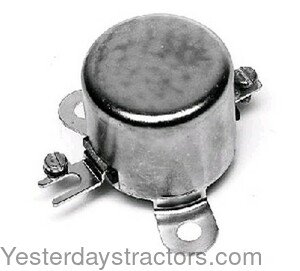
- wm_B0NN10505A.jpg (15.92 KiB) Viewed 3484 times
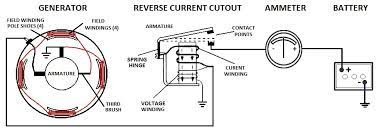
- indexfordt2.jpg (14.19 KiB) Viewed 3484 times
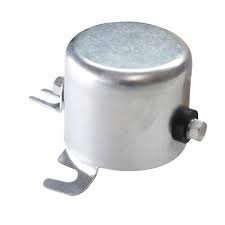
- indexfordt.jpg (5.08 KiB) Viewed 3484 times
A member mentioned that cutouts/voltage regulator were hard to find. Yet those with Ford 2N/9N tractors can get such cut outs.
The diagrams for a simple charging system appear similar.
So what memo did I miss?
Re: Are these the same
Posted: Fri Jun 17, 2022 1:09 pm
by Mark Gregush
If they are coil type, yes. The coil wound type do not care what polarity is grounded. The ones shown, are just a cut out not a regulator.
Re: Are these the same
Posted: Fri Jun 17, 2022 2:13 pm
by speedytinc
I think you are not clear on the differences. A simple explanation.
The original style cut out is an electro-mechanical switch. It has a set of points. When the Gen produces a bit more voltage than the battery, the electromagnetic closes the points for electricity to charge the battery. When the gen is not producing enough or the motor isnt running, the points open so that battery power doesnt feed back into the gen to ground shorting out.
An electronic cut out is a diode that allows electricity to flow one way to the battery from the gen. No points or mechanical stuff to fail.
A voltage regulator, REGULATES the gen output. It feeds power to the battery only what it needs to maintain the proper voltage level. It must be built to a specific battery voltage, where as a diode(if rated high enough) will work for any battery you are using, 6,8 or 12V.
Electronic VR's will stop feeding voltage when the battery is full by putting the output to ground. That disables the gen temporarily & usually by rapid pulsing off & on. The beauty of a regulator is that the battery doesnt get overcharged. This minimizes maintenance & maximizes battery life.
Fun projects built VR's for model T's. This was a new technology brought to model T's. A wonderful improvement to the charging system. These are no longer being made. Hopes are that a similar thing will become commercially available.
Re: Are these the same
Posted: Fri Jun 17, 2022 2:14 pm
by Scott_Conger
After reading the page you supplied, it appears that they are marketing a combination cut-out/vibrating point-style voltage mechanical regulator. Not something I'm prepared to put into my car.
No one in the Model T community ever offered such a device to owners. The Voltage Regulator which everyone laments the demise of, was a solid state device. This one is not.
Re: Are these the same
Posted: Fri Jun 17, 2022 2:19 pm
by speedytinc
These cheap repo cutouts are known to regularly fail & destroy your generator.
Re: Are these the same
Posted: Fri Jun 17, 2022 2:25 pm
by TRDxB2
The above explanation is the best that can be given. The items you show are cutouts. No if you read between the lines a VR is like a cutout but shuts down the voltage to the battery so it doesn't get overcharged. Keeping things in balance. Now if have a cutout you can stop overcharging the battery by turning the lights on in the daytime so the ammeter shows negative and turn them off basically you are almost doing the same thing as the VR.
T owner's need to be more worried about overcharging a battery then having to recharge it.
Re: Are these the same
Posted: Fri Jun 17, 2022 3:49 pm
by Mark Gregush
RE the cutout; The only thing I see on the page supplied, which looks to be from a Ford Service manual, is how to adjust the voltage the points open and close, which is the same information as in my WW2 surplus generator testing outfit handbook.
Re: Are these the same
Posted: Fri Jun 17, 2022 4:00 pm
by Scott_Conger
Mark, reread it.The page supplied describes a cutout compatible with a 3 brush generator, and it describes a vibrating voltage regulator for a 2 brush generator (not a "T" generator). I'm not entirely sure from the pictures posted by George that the pictures are in fact both cutouts (though they DO look like it), but most certainly, the description page is referring to both a cutout and a VR (albeit not a very sophisticated one); two entirely different products, doing two entirely different things. For what it's worth, neither one of which would I put on my car.
George appears to be confusing two entirely different things; cutouts, which are available for "T"s and Voltage Regulators for "T"s which are not available, and has found a source for 2 brush generator VRs which cannot under any circumstance be used on a T.
For all the hopeful folks trying to follow this: there do not presently exist any VRs compatible with "T"s that I am (still) aware of.
For Model A's, positive ground, here is a description by the designer as to how a vibrating voltage (voltage sensitive relay) operates as a VR. Still something I would NOT put in my car even if I could:
http://www.fordgarage.com/pages/generator.htm
Re: Are these the same
Posted: Fri Jun 17, 2022 6:41 pm
by TXGOAT2
All of the old-style 2 element regulator/cutouts I"ve seen are in a square metal box with 3 or more terminals. I think a T generator could be adapted to operate with a 6 V negative ground 2 or 3 element regulator, but you'd have to take it apart and bring the grounded field lead out to an insulated terminal on the generator frame. I think the regulator would prevent the generator running away, since it limits field current. You could leave the third brush arrangement intact and use it to limit the generator's maximum output.
Re: Are these the same
Posted: Sat Jun 18, 2022 10:04 am
by Been Here Before
A cut out is by design a voltage regulator. When the motor is running and the generator is producing voltage, and the cut out allows the current/voltage from the generator to reach the battery. When the motor is stopped the voltage/current is cut out of the circuit, when the generator is not producing voltage and the voltage in the battery is not flowing back to the generator.
The cut out is acting similar to a diode - a diode allows current/voltage to flow in one direction only. The solid state voltage regulating controls that are use is a Zener Diode. The diode is designed to reliably allow current to flow "backwards" when a certain set reverse voltage. When the generator is producing voltage the diode allows the voltage to flow back ward to the battery.
Should the diode be set up in reverse, the voltage would flow reversed from the battery to the generator.
see: Automobile Engineering, 1922, pp 328-333.
PS: Why does the voltage output regulation of the generator have to be so sophisticated? see:
https://www.cool386.com/ford_regulator/ ... lator.html
Knives out.
Re: Are these the same
Posted: Sat Jun 18, 2022 10:23 am
by TXGOAT2
A cut out is an automatic switch. It turns the generator on or off. It does not regulate generator output. A diode, as retro-fitted to T generators, is a solid state device that allows electric current to flow through it in one direction only. It performs the same function as the cut out. A proper generator regulator is a more complex device that turns the generator off and on as required, and also it regulates the generator's output voltage, or voltage and current, according to the vehicle requirements. A regulator will consist of 2 or 3 seperate elements: (1) The cut out, which works like a stock T cutout. (2) a voltage regulating element, which limits generator output voltage to a specified range regardless of generator RPM or load. (3) Some regulators also contain a current regulating element, which limits generator current output as required to suit the accessory load and the battery's requirements. A Model T generator will not work with an old style external voltage regulator without modification. NOTE: The solid state regulators that have been offered for Model T generators are a different device entirely than the old style electro-mechanical cutouts, the diode cut out conversions, or any of the old style electromechanical regulators. The solid state "Fun Projects" type cut out repalcement (If you can find one) is a multi-function electronic device that performs both cut out functions and generator regulation functions. This type regulator will replace the original cut out and provide the cut out function and also wil provide voltage regulation, and no modification to the generator or wiring is required.
Re: Are these the same
Posted: Sat Jun 18, 2022 10:29 am
by Been Here Before
TXGOAT2 wrote: ↑Sat Jun 18, 2022 10:23 am
A cut out is an automatic switch. It turns the generator on or off. It does not regulate generator output. A diode, as retro-fitted to T generators, is a solid state device that allows electric current to flow through it in one direction only. It performs the same function as the cut out. A proper generator regulator is a more complex device that turns the generator off and on as required, and also it regulates the generator's output voltage, or voltage and current, according to the vehicle requirements. A regulator will consist of 2 or 3 seperate elements: (1) The cut out, which works like a stock T cutout. (2) a voltage regulating element, which limits generator output voltage to a specified range regardless of generator RPM or load. (3) Some regulators also contain a current regulating element, which limits generator current output as required to suit the accessory load and the battery's requirements. A Model T generator will not work with an external voltage regulator without modification.
I thought the output voltage of a DC generator was controlled by the RPM of the commutator? The cut out was activated when a designed voltage/current is achieved by the generator?
Re: Are these the same
Posted: Sat Jun 18, 2022 10:35 am
by Scott_Conger
comment self-edited as the original posting did not advance the conversation for the betterment of the reader.
Re: Are these the same
Posted: Sat Jun 18, 2022 10:42 am
by TXGOAT2
++++ Re: Cut out and generator speed: If you have a Model T generator using a stock cut out, it only cuts out when the engine stops, or is running very slowly. The cut out does not limit generator output. (The third brush can be manually adjusted, within limits, to increase or decrease current/voltage output at any given speed and limit maximum output) Starting in the 1930s,cars began to be equipped with voltage regulators. These devices included a cut out and also had a device that automatically controlled the generator's field current. This allowed the generator output to more closely match the electrical demands of the battery and the electrical accessories across a fairly broad range of electrical demands and generator speeds. The stock Model T cut out has no regulatory function beyond turning the generator on or off depending on whether the engine is running or not. Whenever the engine is running, the T generator MUST be connected to the car's electrical system. When the engine is not running, the T generator MUST be disconnected from the rest of the system.
Re: Are these the same
Posted: Sat Jun 18, 2022 10:50 am
by TRDxB2
Pictures help
NOTE: The current (amperage) is regulated, 3rd brush, inside the Model T generator. That is why many 6volt VR don't work for a Model T. Also the Fun Projects VR just the works the cutout and voltage regulation functions
These images are just to show what is being managed in a VR versus a cutout in a typical system - not a Model T
http://www.secondchancegarage.com/public/83.cfm
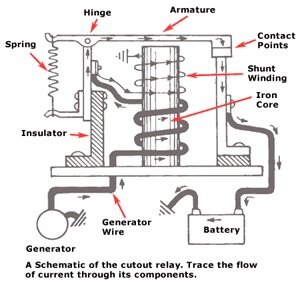
- photo2.jpg (23.22 KiB) Viewed 3176 times
Re: Are these the same
Posted: Sat Jun 18, 2022 11:04 am
by TXGOAT2
Re: Diagram of 3 element regulator and generator: Note that the generator has one commutator brush grounded and the other brush brought out to an external "output" terminal, the same as a Model T generator. However, unlike the T generator, which has one end of the field circuit grounded and the other end (manually adjustabley) connected to generator output via the internal "third brush", the two brush generator has ****ONE ** end of the field circuit connected to the ungrounded (output) brush and the other end brought out to an external terminal, rather than being grounded. This allows constant, automatic regulation of the field current, and thus of the generator output. Field current is sourced directly from the generator output and regulated by inserting resistance between the field circuit and ground. Regulating field current directly regulates generator output.
Re: Are these the same
Posted: Sat Jun 18, 2022 11:11 am
by Been Here Before
TRDxB2 wrote: ↑Sat Jun 18, 2022 10:50 am
Pictures help
NOTE: The current (amperage) is regulated, 3rd brush, inside the Model T generator. That is why many 6volt VR don't work for a Model T. Also the Fun Projects VR just the works the cutout and voltage regulation functions
These images are just to show what is being managed in a VR versus a cutout in a typical system - not a Model T
http://www.secondchancegarage.com/public/83.cfm
photo2.jpg
I found this on line:
https://www.cool386.com/ford_regulator/ ... lator.html
And this statement:
"In recent times (end of 2021), there has been a lot of interest on the MTFCA forum about voltage regulators, since the Fun Projects regulator is in short supply. It has certainly been a popular accessory over the years, and from all reports, as well my own experience, it works very well. With some encouragement from forum members Mike Kossor (the designer of the ECCT, E- timers, and I-Timers), and Luke, a fellow electronics and Model T enthusiast, I decided to finish my project."
And going from Something simple like this:
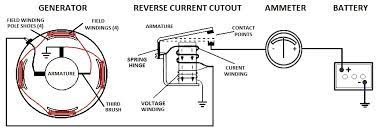
- indexfordt2.jpg (14.19 KiB) Viewed 3154 times
And something complicated as this pic of an electronic voltage regulator:
And I am beginning to see how, for me, all the fun of owning and operating a Model T is fading.....
Re: Are these the same
Posted: Sat Jun 18, 2022 11:17 am
by TXGOAT2
You do not have to modify your T just because parts may be available to do so. The stock system is adequate for a stock car if adjusted as needed.
Re: Are these the same
Posted: Sat Jun 18, 2022 6:02 pm
by Scott_Conger
If you run a cut-out like designed in 1919, set the generator to 10A as advised in 1919, and then drive for 8 hours at 35-40 MPH all day for 5 days on a tour, you can expect to boil the battery. Boil the battery often enough and you'll be replacing it fairly early on in its life.
Simple
If you keep your speeds to 15-20 MPH and drive for only an hour or so per day, you will not likely boil your battery
Simple
Re: Are these the same
Posted: Sat Jun 18, 2022 6:22 pm
by J1MGOLDEN
The only good things about the first two cutouts photographed is the cases can be used to remove the insides to be modified by installing a diode.
If you install the diode backwards, you can still sell it to a Model A owner, as it will work fine for them.
Re: Are these the same
Posted: Sat Jun 18, 2022 8:27 pm
by TRDxB2
Scott_Conger wrote: ↑Sat Jun 18, 2022 6:02 pm
If you run a cut-out like designed in 1919, set the generator to 10A as advised in 1919, and then drive for 8 hours at 35-40 MPH all day for 5 days on a tour, you can expect to boil the battery. Boil the battery often enough and you'll be replacing it fairly early on in its life.
Simple
If you keep your speeds to 15-20 MPH and drive for only an hour or so per day, you will not likely boil your battery
Simple
Your assessment is entirely correct. To many people are worried more about draining a battery than overcharging it. Setting the 3rd brush to output about the same amperage draw as the cars headlights when on ( let the ammeter show a slight discharge) in the daytime while driving will keep a battery healthy and add a bit of visibility to other drivers. If one is concerned with the battery running low, doubtful, turn the lights off for awhile to charge the battery. You too can be the Voltage Regulator. Today's battery specs, Cold Crank Amps, are inapplicable to a Model T. The important spec which is often omitted is
Ampere Hours, Ah, a 5amp draw on a 400 Ah battery would provide power for nearly 70-80 hours (400/5).
Re: Are these the same
Posted: Sat Jun 18, 2022 8:49 pm
by TXGOAT2
In my world, batteries rarely deliver their full rating. The settings recommended above are about the best you can do with a stock T system. If you want to use the headlights to load the generator to prevent overcharging during daytime driving, you would need to remember to turn the lights off when you stop or drive slowly for extended periods. Q: What if you left the stock T generator and light system entirely original, but added a second regular cutout connected between the generator wire and the "dim" light connection at the firewall terminal strip. That would illuminate the dim lights whenever the generator was charging, but would automatically cut out when it was not charging. The headlight switch would function normally.